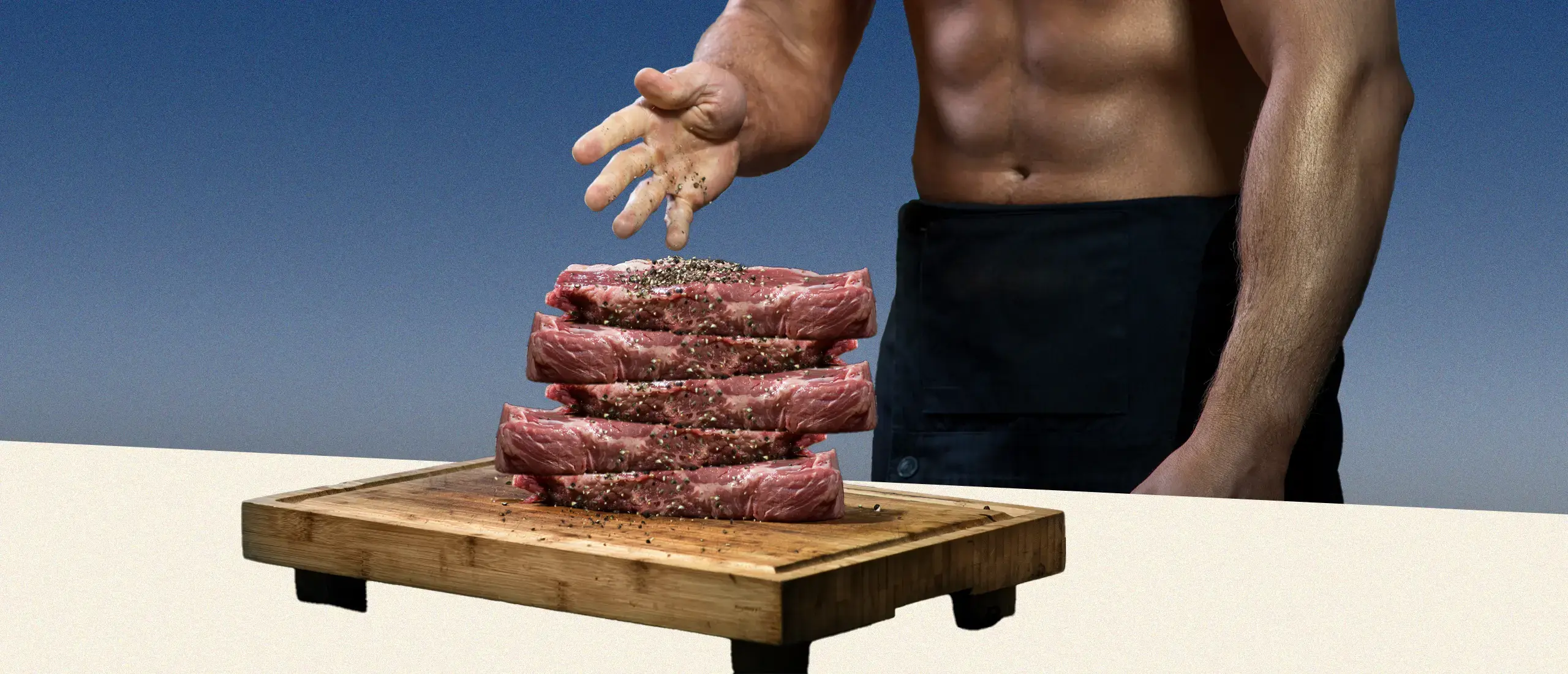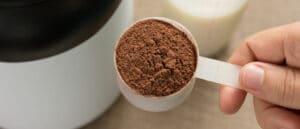New Study Suggests There’s No Such Thing as Too Much Protein
- By Sydney Bueckert, NASM C.P.T., C.E.S., F.N.S., G.P.T.S.
- February 7, 2024
To build muscle, the go-to research-based recommendation for protein intake has been in the ballpark of 20 to 30 grams per meal, repeated three to four times a day. Anything beyond that amount is used as fuel. But a new study is challenging the maxim of how much protein you can chow down (and use for gains) in a single sitting (1).
A study recently published in Cell Reports Medicine found that eating 100 grams of protein led to a higher and more sustained spike in muscle protein synthesis (MPS)—the process of producing more muscle—compared to 25 grams of protein (2). The study concluded that “the anabolic response to protein ingestion has no apparent upper limit in magnitude.” In other words, you can eat as much protein as you want in one sitting, and it will be used to build muscle.
But is cramming more protein into one meal a solid option for muscle growth? And how much protein is too much? We tapped a handful of registered dietitians to find out.
About the Experts:
- Brian St. Pierre, MS, RD, CSCS is a registered dietitian and the Director of Nutrition and Performance at Precision Nutrition who specializes in breaking down nutrition science through a fitness lens.
- Brittany Werner, MS, RDN, LDN is a registered dietitian and Director of Coaching at Working Against Gravity, a nutrition program that combines scientific knowledge and practical strategies to help clients lose weight and build muscle and strength.
- Sydney Greene, MS, RDN is a registered dietitian and nutritionist. She’s passionate about debunking dangerous fad diets.
What Did the New Research Show?
The study assigned healthy young men to three different protein loads (25 grams of protein, 100 grams, and no protein) from the same source: isolated milk protein from cow’s milk. All groups completed a resistance training session, immediately followed by their assigned dose of protein. Researchers then tracked the body’s response—including the magnitude and duration of absorption, muscle protein synthesis rates, and whole body net protein balance—over a 12 hour period.
They found a dose-response relationship between protein intake and muscle protein synthesis: the larger the protein load, the greater (and longer) the MPS response.
Although both protein groups also burned excess amino acids for energy (the 100 gram group, moreso), the amount of protein burned was minor compared to the amount of protein used for muscle protein synthesis.
In non-science terms? Even if you eat a large amount of protein in one meal, that protein is still effectively used by the body to build muscle. Although, it might take your body longer to digest and absorb the protein.
Should You Load More Protein Per Meal?
You can. “It certainly seems that for most of us (i.e., not bodybuilders whose livelihoods depend on every ounce of muscle they can gain), loading protein like this might be a viable option on busy days,” says registered dietitian Brian St. Pierre, MS, RD, CSCS, the Director of Nutrition and Performance at Precision Nutrition. But that doesn’t necessarily mean you should make extra high-protein meals your default. Here are a few things to consider:
Total protein is king
“Measuring short-term changes in MPS helps us ask better research questions, but the most important data is research on muscle gained over time. Based on what we know right now, total protein intake matters the most by far,” says St. Pierre.
For a daily protein goal, St. Pierre suggests aiming for 1.6 to 2.2 grams/kg of bodyweight (or about 0.75 to 1 gram/pound). “You can still make great progress if your protein intake falls short of that, and ends up more in the 1.2 to 1.6 g/kg range (around 0.55 to 0.75 g/lb). It just likely won’t be as good as it could be if your protein intake was a bit higher,” he adds.
Your goals and age also matter, so the smartest bet is to enlist a certified nutritionist or registered dietician to help you create a personal protein plan, says registered dietitian Brittany Werner, the Director of Coaching at Working Against Gravity.
Protein source matters
It’s worth pointing out that the proposed 20 to 30 gram anabolic threshold is largely based on studies that used whey protein (1).
Isolate milk protein (the source of protein used in the new study) is 80 percent casein protein, and 20 percent whey, says St. Pierre. Casein digests and absorbs much slower than whey, which is typically absorbed within one to two hours after you eat.
The protein makeup of isolate milk protein explains the sharp initial spike in MPS (whey), and the ongoing elevated levels in MPS (casein) even 12 hours after ingestion in the 100 gram protein group. In other words, powering down some milk or a casein protein shake before bed or a long block of meetings may increase the max potential for protein utilization (compared to a whey protein shake, for example) by distributing the absorption of that protein across a longer range of time.
“The results [of the study] might be different with whey or plant protein versus milk protein,” St. Pierre points out. For example, the anabolic response to whey protein might very well cap out at 20 to 30 grams of protein, since it’s digested and absorbed much quicker than casein. “Some plant sources may have lower protein content or be less digestible than animal-based sources,” adds Werner.
Meal format matters
“More than thinking of the type of protein, it is important to think about what is being consumed alongside the protein,” says registered dietitian Sydney Greene, MS, RDN. “Unless you’re drinking a protein shake, most protein is consumed alongside carbohydrates and fat—these different nutrients will affect digestion and absorption.”
For instance, one study suggests that 70 grams of protein in the context of a full meal improved whole body net protein balance (meaning, muscle protein synthesis exceeded muscle protein breakdown) when compared to 40 grams (3). Each meal consisted of a mix of protein (from beef), fat, and carbs—a format that would absorb far more slowly than pure whey protein.
In other words, eating a balanced meal can slow down protein absorption, and potentially boost the muscle-building potential of a meal.
Even protein distribution might still be better
The general consensus is to aim for four meals of 0.4 to 0.55 grams of protein/kg of bodyweight per day to maximize MPS and muscle growth (1). However, according to St. Pierre, we don’t know that four meals is better than the same total amount of protein split between three meals, or two.
“We suspect it to be better, as other research has indicated there is an upper limit to MPS from protein intake, and that having three to four MPS spikes throughout the day seems to be superior. But that data is not conclusive,” St. Pierre explains. “I do suspect three to four protein-rich meals per day is likely better, but how much better remains to be seen. And it may not make a significant enough difference for most compared to, say, two meals.”
Still, St. Pierre suggests dividing your total protein over three to four meals per day, with a minimum of 30 grams of protein per meal. “Distributing protein intake evenly across meals, including post-exercise, helps to support MPS throughout the day,” agrees Werner.
More research is needed
“I’m always cautious to suggest clients change behaviors from one study, especially a study with a small and homogenous sample size (36 young men),” says Greene. St. Pierre agrees that population matters. “Other research has shown that MPS spikes quickly in more highly trained individuals, but also falls off faster. This study used recreationally trained individuals, who spike MPS more slowly and it lasts longer,” he explains. Older adults also need to eat more protein at each meal to achieve the same level of MPS (4).
St. Pierre also points out that this study looked at short-term markers of muscle growth (muscle protein synthesis), not actual muscle gain. “Studies looking at actual muscle gain do tend to slightly favor having a more even distribution throughout the day, though not to a dramatic degree (1),” says St. Pierre.
Can Too Much Protein in One Meal Be Harmful?
“As long as you are adequately hydrated and are also eating lots of veggies and fruits with your protein, 100 grams of protein in one sitting is not a concern,” says St. Pierre. 2.2 grams of protein per kg of bodyweight (1.1 g/lb) is a good general ceiling for protein intake, he adds.
Some research has linked high-protein diets (>1.5 g/kg) with poor kidney health (5). However, Greene, Werner, and St. Pierre agree high protein diets are considered safe for most healthy individuals. According to Werner, a high protein diet can help maintain and boost muscle strength and mass—which naturally decreases with age without regular strength training and adequate protein intake.
However, if you have a pre-existing kidney condition, or an underlying health concern you might want to hold off on increasing the protein. Consult a healthcare professional or registered dietitian to tweak your protein intake for you, says Werner.
References
1. Schoenfeld, B. et al. (2018). How Much Protein Can the Body Use in a Single Meal for Muscle-Building? Implications for Daily Protein Distribution.
2. Trommelen, J. et al. (2023). The Anabolic Response to Protein Ingestion During Recovery From Exercise Has No Upper Limit in Magnitude and Duration in vivo in Humans.
3. Kim, I. et al. (2016). The Anabolic Response to a Meal Containing Different Amounts of Protein is Not Limited by the Maximal Stimulation of Protein Synthesis in Young Healthy Adults.
4. Putra, C. et al. (2021). Protein Source and Muscle Health in Older Adults: A Literature Review.
5. Ko, G. et al. (2020). The Effects of High-Protein Diets on Kidney Health and Longevity.
















